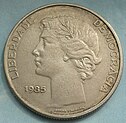Portuguese escudo
| Escudo português (Portuguese) | |||||
|---|---|---|---|---|---|
| |||||
| ISO 4217 | |||||
| Code | PTE | ||||
| Unit | |||||
| Unit | Escudo | ||||
| Plural | escudos | ||||
| Symbol | |||||
| Denominations | |||||
| Superunit | |||||
| 1000 | conto | ||||
| Subunit | |||||
| 1⁄100 | centavo | ||||
| Plural | |||||
| centavo | centavos | ||||
| Banknotes | |||||
| Freq. used | 500 | ||||
| Rarely used | 100 | ||||
| Coins | |||||
| Freq. used | 1 | ||||
| Rarely used | 2+1⁄2 | ||||
| Demographics | |||||
| User(s) | None, previously: | ||||
| Issuance | |||||
| Central bank | Banco de Portugal | ||||
| Website | www | ||||
| Mint | Imprensa Nacional-Casa da Moeda | ||||
| Website | www | ||||
| Valuation | |||||
| Inflation | 2.8% (2000) | ||||
| Source | worldpress.org | ||||
| EU Exchange Rate Mechanism (ERM) | |||||
| Since | 19 June 1989 | ||||
| Fixed rate since | 31 December 1998 | ||||
| Replaced by euro, non cash | 1 January 1999 | ||||
| Replaced by euro, cash | 1 January 2002 | ||||
| 1 € = | 200.482 PTE | ||||
| This infobox shows the latest status before this currency was rendered obsolete. | |||||
The Portuguese escudo was the currency of Portugal from 22 May 1911 until the introduction of the euro on 1 January 2002. The escudo was subdivided into 100 centavos. The word escudo derives from the scutum shield.
Amounts in escudos were written as escudos ![]() centavos with the cifrão as the decimal separator (for example: 25
centavos with the cifrão as the decimal separator (for example: 25![]() 00 means 25.00 escudos, 100
00 means 25.00 escudos, 100![]() 50 means 100.50 escudos). Because of the conversion rate of 1,000 réis = 1
50 means 100.50 escudos). Because of the conversion rate of 1,000 réis = 1![]() , three decimal places were initially used (1
, three decimal places were initially used (1![]() = 1
= 1![]() 000).
000).
History[edit]
The currency replaced by the escudo in 1911 was denominated in Portuguese reals (plural: réis) and milréis worth 1,000 réis. The milréis was equivalent to 2.0539 grams fine gold from 1688 to 1800, and 1.62585 g from 1854 to 1891. Gold escudos worth 1.6 milréis (or 1.600![]() ; not to be confused with the 20th-century currency) were issued from 1722 to 1800 in denominations of 1⁄2, 1, 2, 4 and 8 escudos.
; not to be confused with the 20th-century currency) were issued from 1722 to 1800 in denominations of 1⁄2, 1, 2, 4 and 8 escudos.
The escudo (gold) was again introduced on 22 May 1911, after the 1910 Republican revolution, to replace the real at the rate of 1,000 réis to 1 escudo. The term mil réis (thousand réis) remained a colloquial synonym of escudo up to the 1990s. One million réis was called one conto de réis, or simply one conto. This expression passed on to the escudo, meaning one thousand escudos.
The escudo's value was initially set at 675![]() = 1 kg of gold. After 1914, the value of the escudo fell, being fixed in 1928 at 108.25
= 1 kg of gold. After 1914, the value of the escudo fell, being fixed in 1928 at 108.25![]() to £1 sterling. This was altered to 110
to £1 sterling. This was altered to 110![]() to £1 stg in 1931. A new rate of 27.50
to £1 stg in 1931. A new rate of 27.50![]() escudos to the U.S. dollar was established in 1940, changing to 25
escudos to the U.S. dollar was established in 1940, changing to 25![]() in 1940 and 28.75
in 1940 and 28.75![]() in 1949.
in 1949.
During World War II, escudos were heavily sought after by Nazi Germany, through Swiss banks, as foreign currency to make purchases to Portugal and other neutral nations.[1]
Inflation throughout the 20th century made centavos essentially worthless by its end, with fractional value coins with values such as 50 centavos and 2+1⁄2![]() eventually withdrawn from circulation in the 1990s. With the entry of Portugal in the Eurozone, the conversion rate to the euro was set at 200.482
eventually withdrawn from circulation in the 1990s. With the entry of Portugal in the Eurozone, the conversion rate to the euro was set at 200.482![]() = €1.[2]
= €1.[2]
Territorial usage[edit]
The escudo was used in the Portuguese mainland, the Azores and Madeira, with no distinction of coins or banknotes. In Portugal's African colonies, the escudo was generally used up to independence, in the form of Banco Nacional Ultramarino and Banco de Angola banknotes (rather than those of the Bank of Portugal used in Portugal proper), with Portuguese and in some cases local coins circulating alongside:
- Angolan escudo
- Cape Verdean escudo
- Mozambican escudo
- Portuguese Guinean escudo
- São Tomé and Príncipe escudo
Of the above, only Cape Verde continues to use the escudo.
In Macau, the currency during the colonial period was, as it is today, the Macanese pataca.
Timor-Leste adopted the Portuguese Timorese escudo whilst still a Portuguese colony, having earlier used the Portuguese Timor pataca.
Portuguese India adopted the Portuguese Indian escudo for a brief time between 1958 and 1961 before Goa became a part of India; prior to that, it used the Portuguese Indian rupia.
Coins[edit]




The mintage period for the various denominations of the gold escudo (worth 1.6 milréis or 1.600![]() ) introduced in 1722 was different: 1⁄2 escudo through 1821,[3] 2 escudos through 1789,[4] and 4 escudos through 1799.[5] The eight-escudo coin was only struck between 1722 and 1730.[6]
) introduced in 1722 was different: 1⁄2 escudo through 1821,[3] 2 escudos through 1789,[4] and 4 escudos through 1799.[5] The eight-escudo coin was only struck between 1722 and 1730.[6]
Between 1912 and 1916, silver 10, 20 and 50 centavos and 1![]() coins were issued. Bronze 1 and 2 centavos and cupro-nickel 4 centavo coins were issued between 1917 and 1922.
coins were issued. Bronze 1 and 2 centavos and cupro-nickel 4 centavo coins were issued between 1917 and 1922.
In 1920, bronze 5 centavos and cupro-nickel 10 and 20 centavo coins were introduced, followed, in 1924, by bronze 10 and 20 centavos and aluminium-bronze 50 centavos and 1![]() coins. Aluminium bronze was replaced with cupro-nickel in 1927.
coins. Aluminium bronze was replaced with cupro-nickel in 1927.
In 1932, silver coins were introduced for 2+1⁄2![]() , 5
, 5![]() and 10
and 10![]() . The 2+1⁄2
. The 2+1⁄2![]() and 5
and 5![]() were minted until 1951, with the 10
were minted until 1951, with the 10![]() minted until 1955 with a reduced silver content. In 1963, cupro-nickel 2+1⁄2
minted until 1955 with a reduced silver content. In 1963, cupro-nickel 2+1⁄2![]() and 5
and 5![]() were introduced, followed by aluminium 10, bronze 20 and 50 centavos and 1
were introduced, followed by aluminium 10, bronze 20 and 50 centavos and 1![]() in 1969. Cupro-nickel 10
in 1969. Cupro-nickel 10![]() and 25
and 25![]() were introduced in 1971 and 1977, respectively. In 1986, a new coinage was introduced which circulated until replacement by the euro. It consisted of nickel-brass 1
were introduced in 1971 and 1977, respectively. In 1986, a new coinage was introduced which circulated until replacement by the euro. It consisted of nickel-brass 1![]() , 5
, 5![]() and 10
and 10![]() , cupro-nickel 20
, cupro-nickel 20![]() and 50
and 50![]() , with bimetallic 100
, with bimetallic 100![]() and 200
and 200![]() introduced in 1989 and 1991.
introduced in 1989 and 1991.
Coins in circulation at the time of the changeover to the euro were:
- 1
 (0.50 cent)
(0.50 cent) - 5
 (2.49 cents)
(2.49 cents) - 10
 (4.99 cents)
(4.99 cents) - 20
 (9.98 cents)
(9.98 cents) - 50
 (24.94 cents)
(24.94 cents) - 100
 (49.88 cents)
(49.88 cents) - 200
 (99.76 cents)
(99.76 cents)
Coins ceased to be exchangeable for euros on December 31, 2002.
| Coins of the Portuguese escudo | |||||||||
|---|---|---|---|---|---|---|---|---|---|
| Image | Value | Equivalent in euros | Diameter | Weight | Thickness | Material | Obverse | Reverse | Dates of issue |
 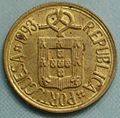
|
1 |
0.50 cent | 16 mm | 1.69 g | 1.2 mm | Nickel-brass | Coat of arms of Portugal and knot | Stained glass window pattern | 1986-2001 |
 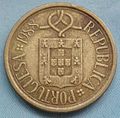
|
5 |
2.49 cents | 21.1 mm | 5.25 g | 2 mm | ||||
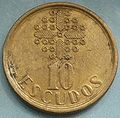 
|
10 |
4.99 cents | 23.5 mm | 7.5 g | 2.3 mm | ||||
 
|
20 |
9.98 cents | 26.5 mm | 6.9 g | 1.64 mm | Copper-nickel | Coat of arms of Portugal | Nautical compass and the cross of the Military Order of Christ | |
 
|
50 |
24.94 cents | 31 mm | 9.41 g | 1.65 mm | Stylized ship and four fishes below | |||
 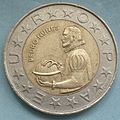
|
100 |
49.88 cents | 25.5 mm | 8.3 g | 2.5 mm | Bi-metallic coin (Aluminium-bronze center plug with a Copper-nickel outer ring) | Pedro Nunes; text "EUROPA" | 1989-2001 | |

|
200 |
99.76 cents | 28 mm | 9.8 g | 2.2 mm | Bi-metallic coin (Copper-nickel center plug with an Aluminium-bronze outer ring) | Garcia de Orta | 1991-2001 | |
Another name for the 50 centavos coin was coroa (crown). Long after the 50 centavos coins disappeared, people still called the 2+1⁄2![]() coins cinco coroas ("five crowns").
coins cinco coroas ("five crowns").
Also, people still referred to escudos at the time of the changeover in multiples of the older currency real (plural réis). Many people called the 2+1⁄2![]() coins dois e quinhentos (two and five-hundreds), referring to the correspondence 2+1⁄2
coins dois e quinhentos (two and five-hundreds), referring to the correspondence 2+1⁄2![]() = 2500 réis. Tostão (plural tostões) is yet another multiple of real, with 1 tostão = 100 réis.
= 2500 réis. Tostão (plural tostões) is yet another multiple of real, with 1 tostão = 100 réis.
Banknotes[edit]

 note (upper) and a genuine banknote (lower) of Banco de Portugal. Both carry the same serial number of 1K 02201, 1922. On display at the British Museum in London
note (upper) and a genuine banknote (lower) of Banco de Portugal. Both carry the same serial number of 1K 02201, 1922. On display at the British Museum in LondonThe Casa da Moeda issued notes for 5, 10, and 20 centavos between 1917 and 1925 whilst, between 1913 and 1922, the Banco de Portugal introduced notes for 50 centavos, 1![]() , 2+1⁄2
, 2+1⁄2![]() , 5
, 5![]() , 10
, 10![]() , 20
, 20![]() , 50
, 50![]() , 100
, 100![]() , 500
, 500![]() and 1,000
and 1,000![]() . 50 centavos and 1
. 50 centavos and 1![]() notes ceased production in 1920, followed by 2+1⁄2
notes ceased production in 1920, followed by 2+1⁄2![]() , 5
, 5![]() and 10
and 10![]() in 1925 and 1926. 5,000
in 1925 and 1926. 5,000![]() notes were introduced in 1942.
notes were introduced in 1942.
The last 20![]() and 50
and 50![]() notes were printed dated 1978 and 1980, respectively, with 100
notes were printed dated 1978 and 1980, respectively, with 100![]() notes being replaced by coins in 1989, the same year that the 10,000
notes being replaced by coins in 1989, the same year that the 10,000![]() note was introduced.
note was introduced.
Banknotes in circulation at the time of the changeover to the euro were:
The last series of escudo banknotes could be returned to the central bank Banco de Portugal and converted to euros until 28 February 2022.
Escudo banknotes celebrated notable figures from the history of Portugal. The final banknote series featured the Age of Discovery, with João de Barros, Pedro Álvares Cabral, Bartolomeu Dias, Vasco da Gama, and Henry the Navigator.
The last 100![]() banknote depicted Fernando Pessoa, the famous Portuguese writer and poet.
banknote depicted Fernando Pessoa, the famous Portuguese writer and poet.
| Banknotes of the Portuguese escudo (1995–2002 "Portuguese seafarers & explorers" Issue) | ||||||
|---|---|---|---|---|---|---|
| Image | Value | Equivalent in Euros (€) | Main color | Obverse | Reverse | Watermark |
| [1] | 500 |
€2.49 | Olive and Violet | João de Barros | Allegory of the Age of Discovery | João de Barros |
| [2] | 1,000 |
€4.99 | Brown and Purple | Pedro Álvares Cabral | Sailing ship, animals of Brazil | Pedro Álvares Cabral |
| [3] | 2,000 |
€9.98 | Blue and deep blue-green | Bartolomeu Dias; Cruzado coin of Dom João II | Sailing ship, compass card, map | Bartolomeu Dias |
| [4] | 5,000 |
€24.94 | Green and brown-violet | Vasco da Gama | Sailing ship, Vasco da Gama with authorities in Calicut | Vasco de Gama |
| [5] | 10,000 |
€49.88 | Red and dark brown | Henry the Navigator (Infante Dom Henrique) | Sailing ship | Henry the Navigator (Infante Dom Henrique) |
Colloquial expressions[edit]
Conto was the unofficial multiple of the escudo: 1 conto meant 1,000![]() , 2 contos meant 2,000
, 2 contos meant 2,000![]() and so on. The original expression was conto de réis, which means 'one count of réis' and referred to one million réis. Since the escudo was worth 1,000 réis (the older currency), therefore one conto was the same as a thousand escudos. The expression remained in usage after the advent of the euro, albeit less often, meaning €5, roughly worth 1,000
and so on. The original expression was conto de réis, which means 'one count of réis' and referred to one million réis. Since the escudo was worth 1,000 réis (the older currency), therefore one conto was the same as a thousand escudos. The expression remained in usage after the advent of the euro, albeit less often, meaning €5, roughly worth 1,000![]() .
.
Occasionally paus, literally meaning 'sticks', was also used to refer to the escudo ("Tens mil paus?" – 'Do you have 1,000 escudos/sticks?'). During the move from escudos to euros the Portuguese had a joke saying that they had lost three currencies: the escudo, the conto, and the pau.
See also[edit]
Notes[edit]
- ^ 1999 by law, 2002 de facto.
References[edit]
- ^ Hayes, Peter (1 April 2015). How Was It Possible?: A Holocaust Reader. University of Nebraska Press. ISBN 9780803274914. Retrieved 8 April 2018 – via Google Books.
- ^ "Use of the euro". European Central Bank. Retrieved 28 November 2016.
- ^ Cuhaj 2009, p. 1147.
- ^ Cuhaj 2013, p. 1253.
- ^ Cuhaj 2013, p. 1254.
- ^ Cuhaj 2013, pp. 1254–55.
Sources[edit]
- Cuhaj, George S., ed. (2009). Standard Catalog of World Gold Coins 1601–present (6 ed.). Krause. ISBN 978-1-4402-0424-1.
- Cuhaj, George S., ed. (2013). Standard Catalog of World Coins 1701–1800 (6 ed.). Krause. ISBN 978-1-4402-3884-0.
External links[edit]
- Overview of the Portuguese escudo from the BBC
- Portuguese escudo coins
- Historical banknotes from Portugal (in English and German)


